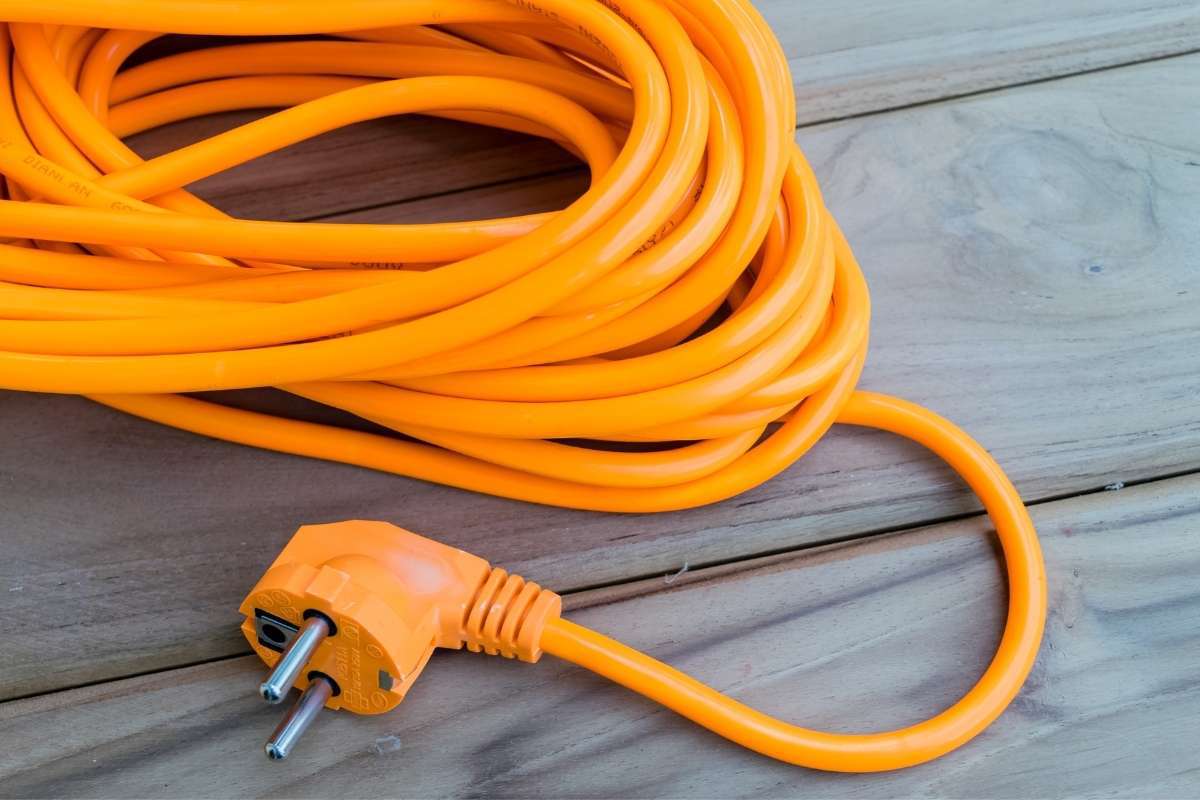Your treadmill is a bit too far away from the wall outlet to plug into it. Can you safely use any extension cord to plug your treadmill into? I’ve done some digging and here’s what I found out.
As long as the extension cord can handle the power draw of the treadmill, using an extension cord is perfectly safe. Most treadmills are built to draw 15 or 20 amps from the wall outlet so, an extension cord that can handle the same is the minimum but more is better.
How you can figure out which extension cord is right for your treadmill can be found below.
Contents
Can You Plug a Treadmill Into an Extension Cord?
In the end, a treadmill is just a big appliance. It needs power to work. How the power gets to your treadmill doesn’t matter as long as it’s safe. Most of the power goes to the electric motor but the console and screens also consume some energy.
A treadmill can be plugged into an extension cord as long as the extension cord can handle the power draw of a treadmill.
Suggested post: Should you unplug your treadmill after use?
All an extension cord does is extend the electric current from the outlet to another place. It’s not a complicated piece of equipment, it just transports electricity. A treadmill needs electric current and plugging it into the extension cord will provide that.
The problem is that treadmills draw a lot of power, especially the ones with a higher-powered motor. That means the extension cord has to be able to handle that.
A treadmill will draw the most power during acceleration. With High Intensity Interval Training (HIIT) this happens often so if you like HIIT, a good power cord is essential. HIIT is a great way to burn more calories in a short period of time and also improve your cardiovascular health. A good interval timer is going to make HIIT workouts much more enjoyable. Check out the GymNext Flex timer. It’s super easy to set up and control contrary to most other interval timers making the setup for any workout a breeze.
Are All Extension Cords Safe To Plug a Treadmill Into?

Because treadmills draw quite a lot of power, not all extension cords are up to the task. If the extension cord can’t handle the amount of power a treadmill needs, bad things can happen. The worst thing is when the cord is too thin for the power draw and heats up the cord. This heat can build up and melt the insulation and things get worse from there.
It’s not safe to just plug your treadmill into any extension cord. Use an extension cord or power strip that can easily handle the power draw of your treadmill.
Read more about taking care of a treadmill’s electronics in this post.
As said above, most of the power a treadmill consumes goes to the motor. More powerful motors require more current. 2hp-4hp motors are very common in domestic treadmills. a 2hp motor can draw up to 1500 Watts, a 3hp motor about 2237 Watts while a 4 hp motor can draw up to 3000 Watts.
A 15-amp extension cord can handle about 1800 Watts while a 20-amp power strip can handle about 2400 Watts. You can see that this might cause issues. Most domestic treadmills have motors around 2-3.5hp so you can see a 20-amp power strip is essential for plugging your treadmill into.
Of course, the motors require the most current when accelerating. Maintaining the same speed takes less power. However, you’ll still have to size the extension cord to the maximum power a treadmill can ask.
Most user manuals will tell you what the electrical requirements are for your specific treadmill. It will usually tell you how many amps they recommend the outlet breaker should be able to handle. So that’s a good guideline to use for the extension cord as well.
That owner’s manual recommendation is the minimum specification you should use for the extension cord. Getting something that has a higher rating than recommended is always good. However, in the end, you’ll be limited by the amount of power the outlet can provide. An extension cord can’t magically provide more current than the outlet it’s plugged into because there is a higher number on it.
You don’t want the extension cord to be the weak link because if the extension cord is overloaded that could result in melting and even fire. If you overload the power outlet, you’ll likely just trip the breaker which is not a big deal. So oversizing the extension cord is always a good idea.
Suggested post: How much does a residential treadmill cost?
If your user manual doesn’t tell you anything about the electrical requirements, it’s a bit hard to be sure but, there are some things you can do to guesstimate your requirements.
- Check the HP rating of the motor. Usually, that’s the continuous power (CHP). If it says CHP, you’ve got to about double it to get to peak HP. If the specs just say ‘HP’ that’s likely the peak rating. The HP rating tells you a lot about the maximum power draw that can happen.
- Now you’ve got the HP rating, convert the HP to watts.
- That’s the amount of watts the motor can produce. That’s the minimum amount of watts a motor needs from the outlet since power doesn’t come from nowhere. However, that doesn’t even take into account the inefficiency a motor has. To be safe, add about 10% to the amount of watts you got.
- E.g. 3 Peak HP = 2237 watts. 2237*1.1= 2460 watt.
- @120 volt that means a roughly 12 amp draw.
- Get an extension cord that can handle at least 12 amps but preferably more than that.
Is that all too complicated? Here’s a shortcut.
- Most power outlets are only rated for 15 or 20 amps. At 120v that means max 3100 watt to 4100 watt for a DC motor (most residential treadmills).
- Because most residential outlets are 15 or 20 amps, the vast majority of residential treadmill manufacturers will recommend that and make sure their treadmills work with that. So if you’re using a ‘normal’ 15/20 A outlet (double check that), get an extension cord that can at least handle that.
- If you want to make super sure that your extension cord can handle it, just buy one that can handle more amps than your outlet can handle. That will be able to handle any treadmill. Oversizing the extension cord won’t hurt anything.
As a side note, the 20 amp outlet is just about enough to work for higher powered treadmills because you don’t really ask the full power from the motor all the time. If you keep tripping a breaker when running at high speed or during acceleration, you’ll have to find an outlet that can provide more amps.
A 6 peak HP (not CHP) motor will draw over 5000 watts at peak. A 20 amp outlet cannot provide that much. Or at least not continuously. A 20 amp outlet can only support about a 5 peak HP motor. That’s about 2.5 CHP.
Treadmills with more powerful motors can therefore benefit from using an outlet that can provide more power. An electrician can help with this.
Suggested post: Should you unplug your treadmill after use?
Tips for using an extension cord with a treadmill
Here are some general tips for using an extension cord with a treadmill safely.
- Make sure you check the rating of the extension cord: Most extension cords out there have their watt/amp rating printed or otherwise advertised on them. Usually, your treadmill’s owner’s manual will also tell you what kind of power the treadmill will draw.
- Unroll the cord completely: If you leave the cord in a coil, the heat doesn’t dissipate properly which can melt the insulation and cause a short especially when you’re drawing a lot of power. If you smell anything like a burning plastic smell, stop immediately and unplug the treadmill.
- Get the shortest extension you can get away with: The longer an extension cord is, the more resistance the wire has. The more resistance there is, the more heat is produced. Also, the voltage drops over distance which can be bad for your equipment.
- Don’t plug anything else into the same extension cord: If a treadmill is already close to the limit of the extension cord/power outlet, make sure you don’t plug anything else in because that could be too much.
- Get a grounded extension cord: It’s always good to plug a treadmill into a grounded outlet. Not all extension cords are grounded so make sure the one you use is.


